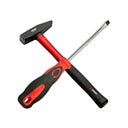Different types of LED strips.
Power consumption and heating under different conditions.
Part 1.
How much does the real power consumption of LED strips differ from the power consumption declared by the manufacturers?
How hot do LED strips of different types, wattages and widths under other conditions?
How hot do LED strips without an aluminum profile?
How hot do LED strips glue directly to the chipboard without an aluminum profile? (under the cabinet)
Samples of LED strips
We bought seven types of popular LED strips on Amazon. Three types of COB LED strips and four types of SMD (traditional) LED strips.
We are not explicitly naming vendors because we think this will only mislead the reader. Most brands of LED products are now temporary brands. The brand is effortless to change if the brand does not mean anything to the seller. Today the product is sold under brand 1, and tomorrow the same product will be sold under brand 2.
We will test products of real A-brands (like IKEA or PHILIPS HUE) in the future, but for now, we are interested in the current Amazon assortment.
The samples have different sector lengths, but we chose a sample length of about 1 foot.
Sample 1.
COB strip.
Sample width: 25/64"
Sample length: 11 13/16"
Sector length: 1 31/32"
Power supply voltage: 24VDC
Declared power consumption: 4,57W/ft
Sample 2.
COB strip.
Sample width: 5/16"
Sample length: 12 13/64"
Sector length: 2 7/16"
Power supply voltage: 24VDC
Declared power consumption: 3.05W/ft
Sample 3.
COB strip.
Sample width: 5/32"
Sample length: 12 13/64"
Sector length: 2 13/32"
Power supply voltage: 24VDC
Declared power consumption: 1.83W/ft
Sample 4.
SMD strip on 2216 chips with a density of 149 chips/ft.
Sample width: 25/64"
Sample length: 11 17/64"
Sector length: 2 13/16"
Power supply voltage: 24VDC
Declared power consumption: 7.01W/ft
Sample 5.
SMD strip on 2216 chips with a density of 81 chips/ft.
Sample width: 5/32"
Sample length: 11 27/64"
Sector length: 1 3/64"
Power supply voltage: 24VDC
Declared power consumption: 3.66W/ft
Sample 6.
SMD strip on 2835 chips with a density of 73 chips/ft.
Sample width: 25/64"
Sample length: 11 13/16"
Sector length: 63/64"
Power supply voltage: 24VDC
Declared power consumption: 6.09W/ft
Sample 7.
SMD strip on 2835 chips with a density of 18 chips/ft.
Sample width: 5/16"
Sample length: 11 13/16"
Sector length: 3 15/16"
Power supply voltage: 24VDC
Declared power consumption: 4.39W/ft
Test bench and measuring instruments
We created a unique test bench for experiments.
A sample LED strip hangs in the air with clips (“third hand” for soldering). The light from the LED strip is directed downward as in a real application (e.g., under a cabinet).
- The voltage is measured with a Greenlee 93–606 multimeter (accuracy for 24V DC = 1.2%).
- Current is measured with a Greenlee DM-65 multimeter (accuracy for DC < 0.6A = 1.2%).
- Temperature is measured with a Fluke TiS65 thermal imager (accuracy for temperatures 80–160 deg F < 3 deg F). The temperature is measured at the bottom (chips) and at the top (base of the strip). The device captures the maximum temperature in the central area of the field of view. This device property helps us find the hottest chips instead of their average temperature.
Measurement of current consumption. Comparison of real power consumption with the power consumption declared by the manufacturers.
Our samples are LED strips powered by DC voltage (not current!). Therefore, we monitored the 24V voltage during the entire test.
We measured each sample’s current consumption and temperature after 30 minutes of operation. During this time, the strip is fully warmed up, and the operating parameters stabilize.
The samples have different lengths. We calculated the power consumption to the relative length of 1 foot to make a fair comparison. We also compared these values to the power consumption stated by the manufacturers of these strips.
We were unpleasantly surprised by samples 2 and 4. Terrible sample 5 with a difference of 23%.
The overall conclusion is sad. The strips have a higher power consumption than the manufacturer claims. The total energy consumption of the lighting system will be more than the buyer wants.
Example. Sample 5 and a 23% difference.
We use this strip to light the room around the perimeter of the ceiling. 60 ft. The calculated power consumption is 220 watts. But in reality, we would need 270 watts.
The difference is 50 watts. And that’s a lot. With a 24V supply voltage, that’s 2 amps. This difference can cause problems in installation and operation. The installer needs other power supplies, other connectors, other wires.
Measuring the temperature of LED strips in the air
Remember that we measured each sample’s temperature after 30 minutes of operation. During this time, the strip is fully warmed up, and its temperature stabilizes.
We measured the temperature of the LED strips in a room with an air temperature of 73 deg F. We recorded the temperature of the hottest chips in the central part of the thermal imager’s field of view.
Without any heat dissipation, the chips heat up to significant amounts. The chips in sample 4 in SMD packages generate the most heat due to their high density, heating each other to 151 deg F.
Is that a lot?
What’s coming up in the next posts?
These measurements will be useful for our next experiments, which will be published soon:
- Strip samples on aluminum profile in air
- Strip samples in chipboard
- Strip samples on aluminum profile in chipboard
========================
Source
My links:
Website
Reddit
Facebook
Instagram
Twitter
Blogger
Tumblr
Youtube
Linkedin
========================
